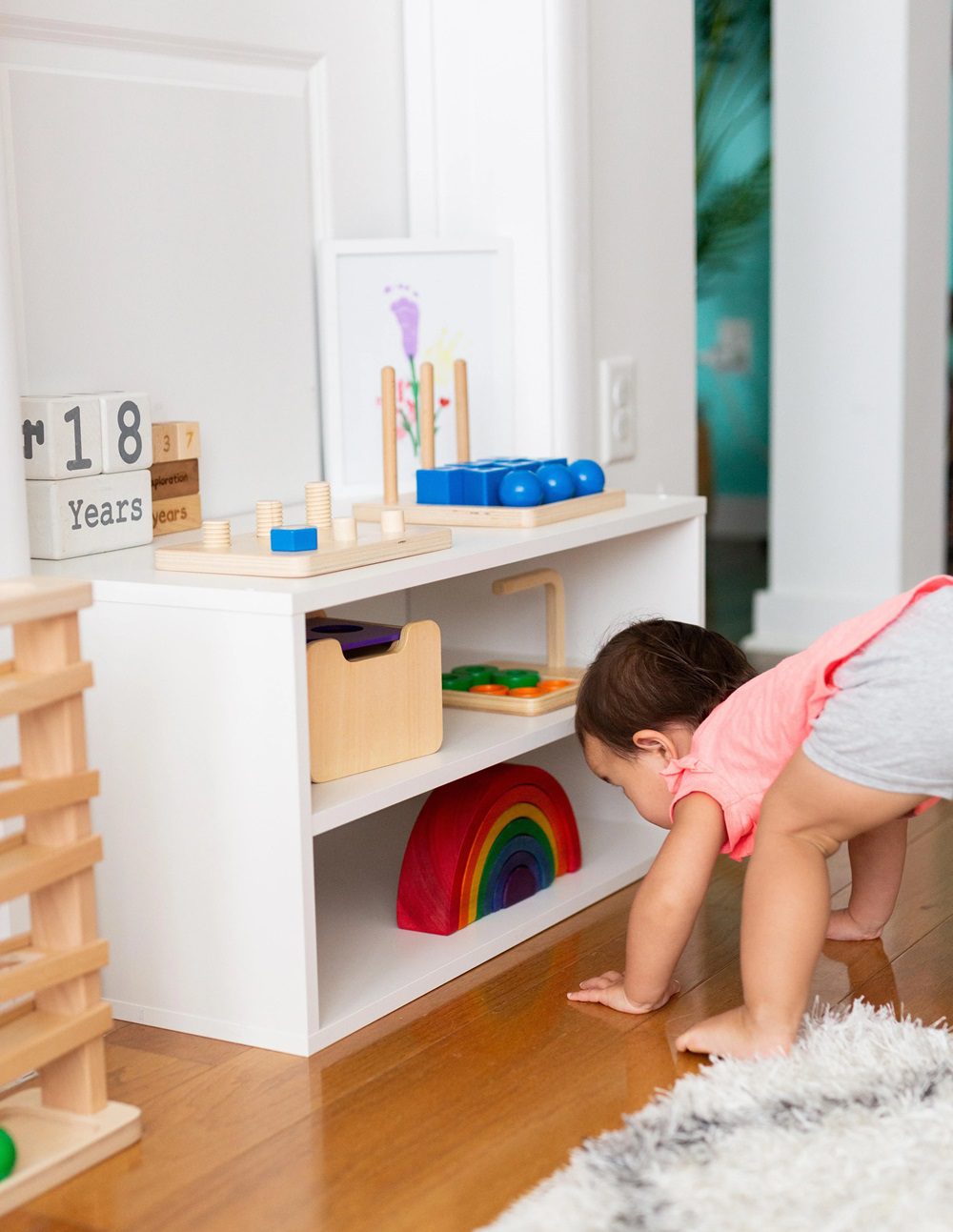
If you have poked around on the internet looking for information about Montessori homes or schools, you have come across the term “Prepared Environment.” The Prepared Environment is any space that is designed to maximize the experiences of the people who use the space. So, a Prepared Environment can be a classroom, a bedroom, the kitchen, dining, living, backyard, park…really any space. We use the term “Prepared Environment” to emphasize that these spaces are deliberately designed and the items in that layout are intentionally chosen.
When it comes to spaces for children, a Prepared Environment has a balance of opportunity and safety. Many companies market tools and gadgets to parents, appealing to their desire to create a safe home with educational experiences. It can be difficult to navigate the marketing and understand what experiences are best for your child and what items will help you create a safe home. Questions to ask, when preparing your home and routine for your child, are: Does this space allow for the freedom of movement that your child needs? Is it free of obstacles to development?
When we ask these questions, we learn what hopes and fears are guiding our parenting choices. Many parents ask:
Should we use baby gates?
When needed, yes. If you are using the gate to maximize independence and movement yet keep your child safe from using the stairs or reaching the stove (as just a couple examples), then yes, use baby gates to create a safe home. However, if you are using baby gates to keep your child from participating in family life (such as helping in the kitchen, independently washing their hands, or choosing activities to play/work with), then you may want to rethink how and why you are using baby gates.

Does a harness allow my impulsive child freedom when we go for walks?
One product that is marketed to parents with the promise of allowing freedom of movement is a harness. A harness gives both the parent and the child a false sense of security. Using a harness can send the message to your child that they are not trusted to explore, that you will control their body and keep them from logical consequences, and that, ultimately, you are in control of their body and they are not. For the parent, you may feel you are allowing your child to explore, but, instead, you are controlling their movement. You are keeping them from developing the skill of learning when and how to stop their own body. Using a harness also does not allow children to experience the capabilities of their bodies.
I understand that, when it comes to safety, it seems that controlling them is the best way. Rather than controlling their body in this way, you can, instead, choose experiences that they are ready to handle. One of my children, when young, was impulsive and would not look before ‘taking off.’ Rather than controlling their body, we changed our patterns to have outdoor experiences where our child could safely practice walking next to us, holding a hand, and then, eventually, just be by our side. We would go to a park or a small market to practice. And until our child understood the expectations and could not be as impulsive, we avoided large, busy parks and busy streets. This was a short period of time, but we dedicated our outdoor time to helping teach this skill, and then we were able to take our family on walks again.
When we see our child as not being able to handle the freedom, our reaction is usually to “lock it down” rather than take the small steps to help us get there. Sometimes our own agendas, busy schedules, or plans get in the way of taking the time children need to learn and understand their bodies and control of movement. The truth may be that a trip to Disney World is not what children can handle when they are in this phase. Rather than see it as denying them the opportunity to experience the magic, you can see that you are supporting their need to understand their bodies and all they can do with them!

Should I use “baby locks” on my cabinets?
When we describe a kitchen that welcomes all family members to take part in food preparation, we recommend having snacks that are accessible and child-size dishes and tools that your child can reach. When you take the time to prepare cabinets with your child in mind, you do not need to use baby locks on these cabinets. Make sure to limit the snacks available to the amount you want your child to eat in a day. When you have dishes and tools available, only make accessible what you have shown children to use safely and have observed them repeat the safe use. For more on this, my book First Foods to Family Meals explains how to create an accessible kitchen and how to prepare food preparation activities.
For cabinets with cleaning supplies and other items that pose a safety hazard, locks are the appropriate limit. When we create spaces that invite a child to take part and also learn limits, we are creating an environment that gives honest feedback. It is OK for your child to learn that not everything they can reach is for them. Additionally, they learn that there is usually a way they can participate safely.
These are just a few examples of how we can remove obstacles to a child’s freedom to move, all while creating safe spaces and experiences. It is through freedom of movement that a child learns controlled, refined, and purposeful movement guided by choice. As you prepare spaces and routines to include your child, remember there is a balance to offering freedom and maintaining safe and consistent spaces.
Follow @familyfriendlyhome for more information on preparing your home, or visit familyfriendlyhome.com.

Sarah Moudry is an education innovator whose work is focused on creating education environments and experiences that inspire growth and joy. Her work is rooted in Montessori philosophy and paired with her extensive experience as a designer. She is a guide at the NewGate school in Sarasota, Florida.
Recently, her projects include the founding of Studio June, a Montessori parent and child education center, and Family Friendly Home, an interior design company that creates inspirational home and school interiors.
Sarah’s most recent book, First Foods to Family Meals (2019), provides parents a Montessori grounding to help them include their children in preparing food at home. Sarah has created online courses that help parents, childcare professionals, and grandparents to incorporate Montessori theory into their lives.
Sarah has an M.Ed in Montessori education, a B.S. in environment and design, AMI Montessori certification for birth to six years, and is an Associate Member of ASID.






